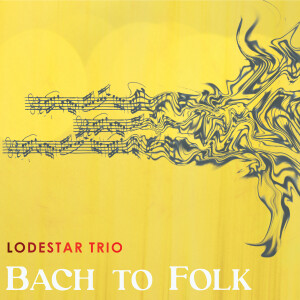 These days I particularly enjoy music that combines roots or folk music with other traditions including jazz and classical. The musicians of Norway, Sweden, Denmark and Finland seem particularly adept at this sort of thing: Norwegian guitarist Jakob Bro, the Swedish ensemble Väsen, Finnish accordionist Maria Kalaniemi … the list is long and includes a lot of fiddlers.
These days I particularly enjoy music that combines roots or folk music with other traditions including jazz and classical. The musicians of Norway, Sweden, Denmark and Finland seem particularly adept at this sort of thing: Norwegian guitarist Jakob Bro, the Swedish ensemble Väsen, Finnish accordionist Maria Kalaniemi … the list is long and includes a lot of fiddlers.
Add to the list Lodestar Trio. Bach to Folk is the debut recording of this trio comprising British-German violinist Max Baillie, Norwegian Hardanger fiddler Olav Luksengård Mjelva (Sver, Nordic Fiddlers Bloc), and Swedish nyckelharpa player Erik Rydvall, who plays in many collaborations including with a Swiss Flamenco group and also in a duo with Olav. Baillie plays mostly classical and is a Bach fanatic, but he’s also involved in many cross-genre collaborations. He apparently saw some online videos of Olav and Erik, sent them an email to ask if they were interested in a collaboration, and received a succinct Nordic response: “Yes.”
Bach to Folk is the result, and it’s absolutely great. It had to wait until pandemic restrictions eased for Max to travel to Norway to record with Olav and Erik at the Røros Church. It was worth the wait, my ears inform me. First and foremost is the sound, which is recognizably Nordic from the unique sonorities of the Hardanger fiddle and nyckelharpa, paired with the classical violin. It’s a very uncommon type of ensemble, and it works beautifully on the repertoire, although Erik had to commission a brand new instrument that could be used to play Baroque music.
One of the pieces that hooked Max when he saw it online was one of everybody’s favorite Bach compositions, “Air from Orchestral Suite No. 3,” also known as “Air on the G String.” You know, the one Procol Harum built their big hit around! It’s more or less the centerpiece on this album, sitting at the 11th track of a very generous 17. The bulk of the works are by Bach – eight of those 17 – but there’s actually quite a bit of variety. From Bach’s own time that we now call Baroque there are songs by the Tarquinio Merula (Spain), Jean-Baptiste Lully and François Couperin (France). Interestingly, the majority of the Baroque tunes are dance tunes – sarabandes, a gavotte, a bourée and a musette from Bach, a chaconne from Merula and a loure from Lully! And some of those that didn’t start out as dance tunes, they’ve almost inevitably given the feel of dance music. Bach’s “Air on the G String” they’ve given just enough (dare I say) swing to conceivably be a stately march of some sort, and the “Prelude from 6th Cello Suite” was already sprightly, but this trio makes it veritably frolic.
They round out the program with some traditional Nordic tunes and some of their own pieces including Erik’s “Jubileumspolska,” which was commissioned by the folkBALTICA festival in Flensburg, and Max’s “Rolling to Røros,” which he composed on his journey to Norway to record the album. A real highlight is Olav’s “Hjaltaren.”
And the album wraps up gently with Olav’s “Deliverance,” a stately and peaceful piece he wrote to celebrate the rising of the sun after a long winter of teaching at a school north of the Arctic Circle. It’s one with which Lodestar often end their concerts with.
The package includes a generous booklet with notes on each track. Bach to Folk is highly recommended for all fans of baroque music and Nordic folk music.
(Arc Music, 2022)
Follow Lodestar Trio on their website | Facebook | Max Baillie website
